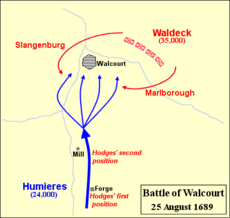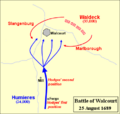Battle of Walcourt facts for kids
Quick facts for kids Battle of Walcourt |
|||||||
|---|---|---|---|---|---|---|---|
| Part of the Nine Years' War | |||||||
 Battle of Walcourt 1689 |
|||||||
|
|||||||
| Belligerents | |||||||
| Commanders and leaders | |||||||
| Strength | |||||||
| 30,000-35,000 | 24,000-30,000 | ||||||
| Casualties and losses | |||||||
| ~100–700 killed or wounded | 2,000 600 killed 1,400 wounded or captured |
||||||
The Battle of Walcourt happened on August 25, 1689. It was part of the Nine Years' War. This fight took place near the old town of Walcourt in what was then the Spanish Netherlands. Today, this area is part of Belgium.
The battle ended a summer of armies moving around and looking for food. It was a big win for the Grand Alliance. This was the only major battle in this area during 1689.
The Allied army was led by the Prince of Waldeck. The French army was led by the Duke of Humières. About 2,000 French soldiers were hurt or captured. The Allies lost fewer than 700 men. This victory was a great start to the war for King William III and the Alliance. However, it badly damaged Humières' reputation as a military leader. He was replaced in the next year.
Contents
Why the Battle Happened
In September 1688, King Louis XIV of France sent his army into the Rhineland. They attacked the German town of Philippsburg. Louis wanted to force the powerful German princes and their leader, Emperor Leopold I, to make a peace deal. This deal would have confirmed France's land gains from earlier wars.
Other German towns quickly fell to the French. These included Oppenheim, Kaiserslautern, Heidelberg, and the important fortress of Mainz. But instead of giving in, the German princes joined together against France. What was meant to be a short fight turned into the long Nine Years' War.
When Louis moved his army into the Rhineland, it made the Dutch Republic feel safer. They had worried about a French attack. This allowed Prince William of Orange to invade England in November. William's success in this event, called the ‘Glorious Revolution’, made him King of England in February 1689. He ruled with his wife, Mary.
Being King of England meant William could use England's power against France. This quickly led to the creation of the alliance he wanted. On May 12, 1689, the Dutch and Emperor Leopold I signed the Grand Alliance. Their goal was to make France give back all the land it had gained since Louis XIV became king.
The Spanish Netherlands later became a main battleground. But in 1689, it was a less important area. This was because the main leaders were busy elsewhere. King William was dealing with problems in England and a rebellion in Scotland. King Louis was busy along the Rhine. German princes were getting ready to push the French army back there.
Getting Ready for Battle
On May 14, 1689, Humières gathered his French army. They met near Boussières on the Sambre river. His army had 24 battalions and 75 squadrons, which means about 24,000 men.
King William gave command of his 35,000 Allied troops to the 69-year-old Prince of Waldeck. The English part of the army, about 8,000 men, was led by the Earl of Marlborough. King William was not sure about the English troops. They were not as organized as the Dutch troops.
However, Waldeck watched as Marlborough worked to organize his soldiers. Waldeck later wrote that he hoped the English "…were as disciplined as they were brave." But by September, Waldeck still complained about their "…temperament, carelessness, terrible clothing and the worst of shoes."
Problems with supplies and late arrivals of troops delayed the Allied attack. It did not start until late June. Waldeck moved his army from near Tienen towards Fleurus. For the next two months, both armies marched back and forth. They tried to get a better position. By August 24, Waldeck had crossed the Sambre river. He set up camp near the small, old town of Walcourt. He was happy to be in enemy land.
The Battle Begins
On August 25, Allied soldiers were sent out to find food. They were protected by 600 English troops from Colonel Hodges' Regiment. Humières attacked these groups and Allied outposts. This happened about 2 miles south of Walcourt. The soldiers looking for food were called back. The Allied camp got ready for a fight.
For almost two hours, Hodges' regiment stopped the main French attack. They covered the retreat of the surprised food-finders. Then, Hodges' troops moved back to a nearby mill. By 11:00 AM, Marlborough saw the fighting. He noticed Hodges' men were being attacked by French cannons. Marlborough ordered Hodges to move his troops to a hill east of Walcourt. The main Allied army was forming behind this hill. Waldeck later told King William that Hodges and the English "…had done amazing things." He added that he "could never have believed that so many of the English would show such a joie de combattre" (joy of fighting).
Even though his troops failed to defeat Hodges' small force, Humières decided to attack Walcourt itself. About 600 Allied men were inside the town. The land was not good for the French. The town's defenses were old, but it was on a hill partly protected by a river. Still, the French attacked several times. They suffered many losses from Allied cannons firing from the side.
Despite the losses, Humières kept trying. He sent some French Guards to try to burn Walcourt's gates. This failed. The town's defenders were made safe when Brigadier-General Thomas Tollemache brought more troops into the town around 2:00 PM. These included the Coldstream Guards and a German Battalion.
Humières had to make the battle bigger. He then sent his men in a sudden attack against the right side of the main Allied line, beyond the town. But around 6:00 PM, Waldeck launched a double counterattack against the tired French. General Slangenburg's Dutch troops attacked their left side. Aylva, with three regiments of foot soldiers, attacked their right. Marlborough supported Aylva with Dutch and English cavalry.
The French army fell back in confusion. But the French cavalry, led by Colonel Villars, did a good job. They stopped the retreat from becoming a complete disaster. This allowed Humières to get his men off the battlefield.
Humières had been defeated. But Waldeck did not chase the French much. This was because a sickness was spreading among his soldiers. The English soldiers suffered the most from this sickness. They had not yet learned to build shelters to stay dry and warm. For a few days, the two armies stayed facing each other, firing cannons now and then. But there was no more fighting. Humières went back to the area of the Scheldt fortresses. Waldeck returned to Brussels.
Some Scottish regiments that fought in the battle were the Scots Guards, The Royal Scots, and the Royal Scots Fusiliers.
What Happened Next
The Battle of Walcourt was the only important event in the whole campaign. It was a sharp and bloody fight. There had not been such a serious battle between the English and French in a long time.
French losses were about 2,000 men and six cannons. The Allies lost between 100 and 700 soldiers. Prince Waldeck praised the 39-year-old Marlborough to King William. He said Marlborough, "…in spite of his youth," had shown great military skill. On September 5, King William rewarded Marlborough. He gave him a good position as colonel of the 7th Foot regiment.
The victory at Walcourt made the Allies more confident. But Humières was disgraced. His colleagues even called him le maréchal sans lumière (the marshal without light). Before Humières went into winter camps, he sent four battalions of French Guards to the Rhineland. There, in 1689, Louis' smaller army faced its biggest challenge.
By 1690, the main fighting of the war moved back to Flanders. For this new campaign, King Louis gave command of the army to the Duke of Luxembourg. On July 1, Luxembourg won a great tactical victory at the Battle of Fleurus.
Images for kids





